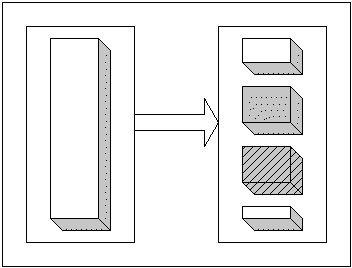|
| Structure | Tips | Theory | WebPoems | Workshops | Books | Articles | Lisa | Jonathan |
Tips |
Insert more headlines and subheads. |
|
 Rationale: Rationale:
In a recent study John Morkes and I found that 79 percent of our test users always scanned any new page they came across; only 16 percent read word by word. As a result, Web pages have to employ scannable text, using…meaningful sub-headings (not "clever" ones). —Nielsen (1997b) Structure articles with two or even three levels of headlines (a general page heading plus subheads and sub-subheads when appropriate). Nested headings also facilitate access for blind users with screen-readers. —Nielsen (1997a) Settle on as few heading styles and subtitles as are necessary to organize your content, then use your chosen styles consistently. —Lynch & Horton (1997) Use anything you can to signal the transition from one topic to the next. —Van Dijk & Kintsch (1983) Original Passage:MRP can handle two kinds of manufacturing—discrete and repetitive. They differ in regularity and costing. When you need to make products in groups or batches, you use discrete manufacturing. You give each batch a job number, a manufactured part number, a quantity (for that particular job), a start date and end date. Because you have a discrete job, you can charge all production costs to that job. With job costing, you can open a job, collect the charges for a job, close out a job, analyze and report costs and variances by job. On the other hand, you may have to manufacture some products continuously. Instead of discrete groups, you have a nonstop flow of products through the line. You define your schedule by the daily rate of production, and you charge the cost of production to the product, on a lump or unit basis. You never close out a schedule; you just vary the rate of production. So you analyze costs by period; when the period closes, you total all charges, and divide that number by the number of products, to get a unit cost, and usage variances, during that period. You choose one method or another for a product when yuou set it up in the inventory. From that point on, MRP will plan production based on the method you have chosen—discrete or repetitive. Revised Passage:We Can Handle Two Kinds of Manufacturing MRP can handle two kinds of manufacturing—discrete and repetitive. They differ in regularity and costing. Discrete Manufacturing Works in Batches When you need to make products in groups or batches, you use discrete manufacturing. You give each batch a job number, a manufactured part number, a quantity (for that particular job), a start date and end date. Costing: Because you have a discrete job, you can charge all production costs to that job. With job costing, you can open a job, collect the charges for a job, close out a job, analyze and report costs and variances by job. Repetitive Manufacturing Just Goes On and On You may have to manufacture some products continuously. Instead of discrete groups, you have a nonstop flow of products through the line. You define your schedule by the daily rate of production, and you charge the cost of production to the product, on a lump or unit basis. You never close out a schedule; you just vary the rate of production. Costing: So you analyze costs by period; when the period closes, you total all charges, and divide that number by the number of products, to get a unit cost, and usage variances, during that period. You Decide You choose one method or another for a product when you set it up in the inventory. From that point on, MRP will plan production based on the method you have chosen—discrete or repetitive. Challenge: Insert headings. For each item on the bill of materials, you need to define whether or not that material will be pushed out of the warehouse, to await use on the line, or pulled from the warehouse just in time to be used during assembly. Pushing ensures all supplies are there on time, but wastes valuable floor space while you wait for the assembly to get to the point where the materials can be used. Pushing resembles traditional manufacturing. Pulling depends on an intelligent conveyor system, triggered by the software, to offload the material from racks, and bring it to the right spot on the floor at the right time. Pulling takes awhile to fine tune, because there are so many physical problems possible, but once pulling has been established, it saves space on the work floor. Pulling is the more contemporary method of manufacturing. Because each item’s method of delivery must be defined when creating the bill of materials, you now need to choose between push and pull.
See: Ameritech (1997), Morkes & Nielsen (1997), Nielsen (1997a, 1997b), Van Dijk & Kintsch (1983) |
Other tips on making your Web prose easy to scan:
|
|
| List of web sites, research articles, and textbooks used to develop the tips. |
Services/Tips/Theory/WebPoems/Workshops/Books/Articles/Lisa/Jonathan
Copyright 1998 Jonathan and Lisa Price, The Communication Circle
Return to our site at http://www.theprices.com/circle
Email us at JonPrice@AOL.com